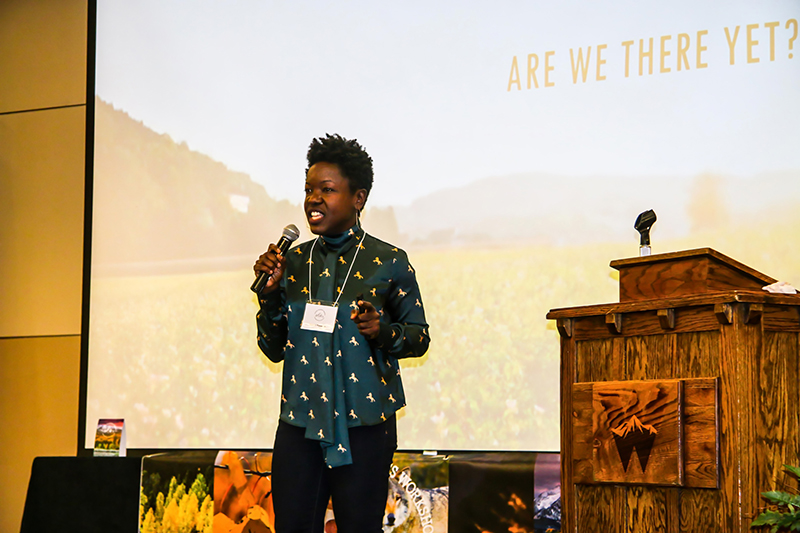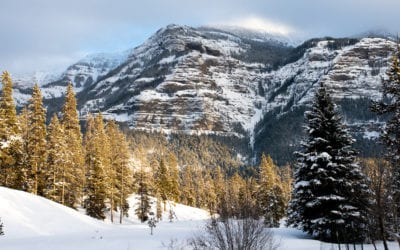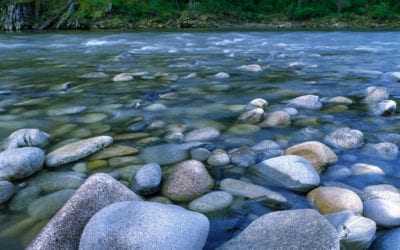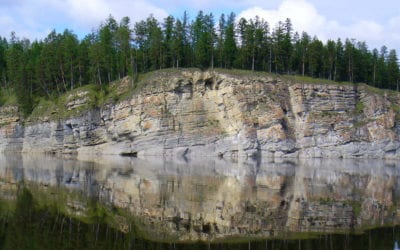© Morgan Heim
Wilderness Was Not America’s New Idea: Exploring a New Wilderness Stewardship Ideal at the 2018 National Wilderness Workshop
Soul of the Wilderness
April 2019 | Volume 25, Number 1
Though parts of this history might still be known to some, it is valuable for these histories to be taught, celebrated and acknowledged continuously – so we’re all aware that people of color have been leading environmental efforts throughout history, and still do. (Estrada 2018)
A New Lens for Wilderness Management
On October 9, 2018, I had the privilege of sitting down with Regina Lopez-Whiteskunk, member of the Ute Mountain Ute Tribe and former co-chair of the Bears Ears Intertribal Coalition, on the deck of the High Alpine Brewery in Gunnison, Colorado, during the welcome gathering of the 2018 National Wilderness Workshop. As I listened to Lopez-Whiteskunk talk, I questioned my relationship with wilderness as primarily composed of recreational experiences in one of the nine Wilderness areas (La Garita, Powderhorn, Fossil Ridge, Raggeds, West Elk, Maroon Bells-Snowmass, Collegiate Peaks, Gunnison Gorge, and Black Canyon of the Gunnison) that have access points within one hour from where we sat. As a student of wilderness, I was humbled as I listened to Lopez-Whiteskunk articulate the thousand-year presence of her ancestors on these lands. Out of respect to her and those who came before, I felt that the least I could do was try to view wilderness through the lens of her and other indigenous peoples whose ancestors forged relationships with wilderness long before Bob Marshall started dreaming of a law that would protect America’s wildest places in perpetuity.
We both shared a high-top table with Dr. Melanie Armstrong, professor and public lands coordinator at Western Colorado University; Western Colorado University dean of the School of Environment and Sustainability, Dr. John Hausdoerffer; and Gavin Van Horn, director of cultures and conservation for the Center of Humans and Nature as well as co-editor, along with Dr. Hausdoerffer, of the book Wildness. The tone of the conversation was spirited for all parties in celebration of the union of the National Wilderness Workshop with the 29th Annual Headwaters Conference, a relationship that emerged out of a shared passion for wilderness stewardship and wild healing. Influenced by the 2020 Vision: Interagency Stewardship Priorities for America’s National Wilderness Preservation System (2020 Vision 2014), Lopez-Whiteskunk joined other arbiters of change as the wilderness community boldly tackled the challenges that make it difficult for underrepresented cultural and economic groups to engage and be recognized in wilderness stewardship activities.
The protected area manager task of balancing a high-quality visitor experience with conservation objectives is becoming increasingly complex. The 2018 National Wilderness Workshop revealed the need for the wilderness and protected area management community to step back for a moment and call upon our interpersonal skills to tactfully develop relationships with past and present wildland stakeholders. The National Wilderness Workshop assembles agency and nongovernment organization employees and volunteers, students, and community members in a learning environment. Specialists engage with colleagues on how to apply current issues to their work. Workshop participants attended sessions focused on culture, science, and management. The Culture Track sessions from this year were particularly memorable. They were were filled with powerful messages that propelled the audience into reconsidering how to make contemporary wilderness management, partnerships, and stewardship initiatives more inclusive of cultural and economic diversity. Panel discussions occurred throughout the workshop, and it became clear through the ideas exchanged and the questions asked that the next step to take as a community of wilderness stewards is far from being defined.
We’ve “Been Outside,” Where Have You Been?
The congressionally designated wilderness areas born from the passage of the Wilderness Act of 1964 represent a wild standard that America is fortunate to steward. The foundation of the wilderness idea, however, can be traced back to the land-based livelihoods of indigenous peoples (Kosek 2006). The onset of Wilderness Character Monitoring on federal lands focuses efforts on measuring the untrammeled, undeveloped, natural, and solitude or primitive and unconfined recreational qualities of wilderness, but do these metrics honor the wilderness values of the original stewards of the wild?
To truly “inspire and nurture life-long connections between people of diverse cultures and wilderness,” as directed by the 2020 Vision, it is time to consider not just who should have a seat at the table, but how to integrate needs and honor the histories of the original guardians of present-day wilderness and protected areas. The “building [of] respectful, long-term partnerships” starts from within each individual wilderness manager to redefine the lens through which protected area management is viewed.
The Culture Track kicked off with a discussion that extracted perceptions on wilderness management and barriers to engagement in wilderness activities. James Edward Mills, 2014 fellow of the Mountain and Wilderness Writing Program of the Banff Center in Alberta, Canada; Melissa Martinez, the wilderness and wild and scenic rivers fellow with the USFS and Hispanic Access Foundation; Eva Malis of the Grand Canyon Trust and the coordinator of the Uplift Climate Conference; and Lopez-Whiteskunk delivered perspectives that addressed wilderness engagement within the communities they represent. The panel brought what some would consider to be uncomfortable issues to center stage from the perspectives of multiple cultural backgrounds and generations.
Malis, 23 years old, has had an interest in working for a federal land management agency, but was deterred by the financial burden of participation in multiple internships prior to applying for an entry-level position. The United States Office of Personnel Management administers USAJOBS.gov, the federal government employment portal. The system aims to attract qualified candidates for positions and honor the civil service tenures of applicants. Because of the high volume of applicants competing for a proportionately small number of vacancies, applicants seek internships or equivalent experiences that place them on a hiring path upon completion of service. Interns are subject to low pay and no guarantee of being hired into a paid position. Malis’s story identified economic access to positions of influence in protected area management as a systemic barrier to engagement, a situation that resonated with many in the room. How can the national wilderness community culturally diversify if the opportunities favor the economically wealthy?
Barriers to engagement with protected areas are not solely economic. Martinez’s work seeks to alleviate the exclusion of Latino families from interacting with wilderness and wild and scenic rivers by celebrating close-to-home forms of these features as well as nearby wild and scenic rivers. Access that is granted by permit systems and advance reservations is a barrier preventing many Latinos from interacting with protected areas. These systems work to the advantage of individuals that have predetermined work schedules with predictable income and time off. However, it is important to realize that just because a Latino family cannot commit to a river permit months ahead of time, it does not mean that wild connections are nonexistent. The wilderness ideal to some are the urban bosque, city park, or rural stretch of river. Although their embodiment of untrammeled, undeveloped, natural, and solitude or primitive unconfined recreation may not be what Howard Zahniser articulated in the Wilderness Act of 1964, it is important to understand this perspective as the wilderness community seeks to engage diverse communities. Martinez utilizes a partnership between the Hispanic Access Foundation and the US Forest Service (USFS) to celebrate wild connections in Latino communities by creating events and content that promote inclusive and sustainable protected area stewardship and foster long-term relationships with the river.
James Edward Mills uncovered another side of this coin. Prior to engagement with National Wilderness Preservation System (NWPS) lands, Mills has a different uphill battle to fight. Mills is African American and has been camping since he was a kid, but while growing up he was told that camping was something that “black people don’t do.” As an outcome of this upbringing, Mills’s work has been focused on bridging the so-called adventure gap in attempts to overcome barriers imposed by society and bring courage to minority communities to get outside. As the opening panel discussion came to an end, Mills had the audience asking a different question: How can a group of minority individuals feel accepted in the wilderness community if their own culture doesn’t think they should be there? The path to the answer was unclear, although exploring the historic relationship of Black, Indigenous, and people of color (BIPOC) individuals with wilderness concepts was further explored in a breakout session by Michael A. Estrada.
Minorities were some of the first wilderness locals, claims Estrada, founder of Brown Environmentalist, a media collective platform elevating the leadership of people of color in the environment. His storytelling campaign, #BeenOutside, seeks to celebrate the many ways that BIPOC individuals have spent time in the outdoors throughout history and continue to enjoy time outside today. Estrada’s millennial twist on this enlightened truth is one in which Lopez-Whiteskunk and others at the workshop agreed.
Sharing Wisdom and Honoring Experience
The factual anecdotes made by the workshop’s speakers were powerful reminders to the wilderness and protected area managers in the room (Figure 1). They brought a new perspective to managers’ role as guardians of the trust doctrine that entitles tribal members to access to their ancestral lands and ecosystems. The federal government’s directive to protect the treaty rights, way of life and property of Native American populations is a fiduciary responsibility that has surfaced in recent decades as the political power of tribes has gained ground in public lands management (Long and Lake 2018). It is a trust responsibility that federal agencies carry out this task to shield tribal lands from societal intrusions (Wood 1995). The publicity of contemporary wilderness issues such as visitor use management can distract from messages about policies that exist on public lands on the basis of tribal sovereignty.

Figure 1 – Kriste Peoples delivers the keynote address at the 2018 National Wilderness Workshop.
Photo credit: James Edward Mills of The Joy Trip Project.
Cooperative management between federal agencies and tribes is built from common values and is inclusive of traditional knowledge of protected lands. Although I fully acknowledge this ideal, I continue to ponder how to integrate it into the contemporary wilderness management issue to which I am committed. Upon learning of my current project in the White River National Forest on the Aspen-Sopris Ranger District of implementing a permit for overnight visits to the Maroon Bells-Snowmass Wilderness, Lopez-Whiteskunk asked what considerations I had made in recognition of the relationship of the Ute Nation to the land. Sitting within earshot, Armstrong and Hausdoerffer also sought to glean insight on the application of an agreement to public lands surrounding the home of their affiliate academic institution.
After graciously accepting my lack of knowledge of any active treaties in either area, she brought to my attention the Brunot Agreement, a treaty signed into law in 1874 between the United States and the Ute Mountain Ute and the Southern Ute as an outcome of mining exploration in the San Juan Mountains of Colorado. The agreement granted miners access to Ute land, a loss to the tribe of more than 5,000 square miles (12,950 sq. km) of reservation land in exchange for $26,000 per year and continued access to tribal members for hunting. The 1874 agreement was renegotiated between Colorado Parks and Wildlife and the Ute Mountain and Southern Ute in 2008 to reinstate pretreaty hunting, gathering, and fishing rights through a Memorandum of Understanding. The reservation lands themselves remain the property of the current private and public landowners. Consultation and compromise took place between each party in 2008 but did not resolve the dispossession of reservation land.
The question remains, How can the wilderness community honor the rich histories of the original guardians of protected areas? One example of a federal land management agency honoring an indigenous wilderness partnership is the return of the sacred Blue Lake area to the Taos Pueblo. After a fight that endured several decades, a 48,000-acre (19,425 ha) segment of the Blue Lake area was ceded back to the Taos Pueblo through HR 471, PL 92-550, the Blue Lake Wilderness Act, signed by President Richard M. Nixon on December 15, 1970. The act was revisited circa 1993 as the Pueblo sought to reclaim the adjacent Bottle Neck Area. Pueblo leadership sought religious claims to the Bottle Neck Area’s sacred Path of Life route that entered into the Wheeler Peak Wilderness Area. Senate Bill 1509 was passed, thus redefining 764.33 acres (309.3 ha) of land within the Carson National Forest and Wheeler Peak Wilderness through its return to the Taos Pueblo.
The Taos Pueblo’s battle for Blue Lake was one of the first successful cases that pinned tribal sovereignty on the basis of religious rights against a public land management agency and set the stage for other tribal nations to defend their land access rights (Hansen 2011). The Taos Pueblo is the primary steward of Blue Lake, which is managed to the same standards as a wilderness area within the NWPS overseen by the Department of the Interior and Department of Agriculture but remains closed to the public. This example of a wilderness management partnership is an attempt to maintain indigenous stewardship ideals (Hansen 2011).
The redesignation of Blue Lake and the lands ceded by the Ute Reservation under the Brunot Agreement represent opposing ends of the spectrum of partnerships that exist between indigenous groups and federal agencies. As stewards, it is our responsibility to know where our guiding policies fall on this spectrum in relation to the ideal management scheme and conduct the stewardship of protected areas accordingly. The National Wilderness Workshop continues to be an event where federal and state employees and wilderness advocates come together to synthesize new information and open new lines of communication with other industry professionals. Stewardship in “trust responsibility” is a task we bear as a community. Revisions to land management documents, such as Land and Resource Management Plans in units of the USFS, present opportunities to integrate this new stewardship ideal.
As tribes across the United States seek to regain their sovereignty and access to ancestral lands and ecosystems, we as managers can be visionary and create a management model that extends beyond a seat at the table. During the second facilitated dialogue of the Culture Track, each speaker was asked to select an ideal management model for wilderness areas. Lopez-Whiteskunk was first to respond that repossession and complete ownership would be her stewardship ideal for the lands of the Ute Mountain Ute Tribe. She noted a cooperative management model as a reasonable approach in this political climate, citing her experience in the fight for Bears Ears. “I know to choose my battles.”
From Outward Vision to Inward Reflection
Bob Marshall’s vision to protect wild landscapes in perpetuity was novel. The NWPS recognizes his contemporary wilderness ideals. My experience at the workshop inspired me to add to these ideals, starting with the launch of a personal investigation into the first stewards of the wilderness areas with which I interact. I am hopeful that as a collective of wilderness and protected area managers, we can train our constituents to associate traditional and sovereign tribal relationships with wilderness with the same thoughtfulness as untrammeled, undeveloped, natural, and solitude or primitive and unconfined recreational qualities. Our task now is to create a stewardship model that honors the founding parameters of the Wilderness Act of 1964, but then to learn how to adapt wilderness management to include the original guardians of wilderness. This is a call to enhance the lens through which modern wilderness and protected area management are viewed and make it more inclusive.
To refocus our vision inward is the most impact we can have today. As the wilderness community explores how to move forward with the interagency 2020 Vision, compassion for the journey taken by the BIPOC individuals we engage with and serve is essential. Maintenance and protection of ecological integrity is a shared value for protected area managers and indigenous peoples. The potential for change lies in the motivation that brings stakeholders to the table, and managers are responsible for learning ahead of time when sensitive issues are at hand. Every question we ask on the topic of inclusion and equity has the potential to raise an emotion or a memory. We need to exercise sensitivity when addressing equity and inclusion by conducting our own research.
Every question we ask on the topic of inclusion and equity has the potential to raise an emotion or a memory. We need to exercise sensitivity when addressing equity and inclusion by conducting our own research.
The sustainability of wilderness and protected areas is impacted by the relationships that foster the connection to our wilderness heritage. The National Wilderness Workshop continues to be a venue for wilderness constituents to ask the tough questions and absorb new information related to the topics of culture, science, and management. The impactful conveyance of the nexus of these topics reminded participants of the symbiosis that naturally ran its course in protected areas prior to the colonization of indigenous lands.
For a conference theme originally conceived to explore how to engage underrepresented wilderness constituents, I assert that the workshop made the wilderness community realize that we have some steps to take before making that leap. The final USFS breakout session revealed that the week had left a powerful impression on agency employees and partners. Few could put into words what we had just experienced. Then, just as Sue Spear, director of wilderness and wild and scenic rivers of the national forest system, opened the floor to questions, Anna Kistner, wilderness ranger intern with the Aspen-Sopris Ranger District, raised her hand and politely asked Spear how she planned on implementing the past week’s topics in the Washington office. Spear’s reply was consistent with the recommendation from our panelists: the journey must start from within. Systemic change takes time. Going back to our districts to engage colleagues in discussion as we conduct our own research is our most impactful action item.
The role of protected area managers is becoming increasingly complex, for good reason, as we strive to increase the inclusivity of current stewardship initiatives on public lands. Our return to the nexus of culture, science, and management benefits from the reintegration of tribal knowledge and values, a system that ran its course on the untrammeled, undeveloped, and natural lands of indigenous ancestors. It is our individual responsibility to educate ourselves about this land use history before we sit down at the table.
LAUREN ATKINSON is a Korean adoptee and member of the National Wilderness Workshop Steering Committee. She is currently working as a resource assistant on the White River National Forest to develop a recreation permit for the Maroon Bells-Snowmass Wilderness while acquiring a master’s degree in environmental management from Western Colorado University. Email: lauren.atkinson@western.edu; LaurenEAtkinson@gmail.com.
References
2020 Vision. 2014. 2020 Vision: Interagency Stewardship Priorities for America’s National Wilderness
Preservation System. Retrieved January 2019, from www.wilderness.net/toolboxes/documents/50th/2020_Vision.pdf.
Estrada, M. A. 2018, September 4. The original tree huggers. Patagonia: The Cleanest Line. Retrieved from https://www.patagonia.com/blog/2018/09/the-original-tree-huggers/.
Hansen, G. 2011. Understanding and building wilderness management partnerships with indigenous peoples and communities. In Science and Stewardship to Protect and Sustain Wilderness Values: Ninth World Wilderness Congress Symposium, November 6–13, 2009, Merida, Yucatan, Mexico, comp. A. Watson, J. Murrieta-Saldivar, and B. Brooke. Proceedings RMRS-P-64. Fort Collins, CO: US Department of Agriculture, Forest Service, Rocky Mountain Research Station.
Long, J. W., and F. K. Lake. 2018. Escaping social-ecological traps through tribal stewardship on national forest lands in the Pacific Northwest, United States of America. Ecology and Society 23(2): 10. doi:10.5751/ES-10041-230210.
Kosek, J. 2006. Understories: The Political Life of Forests. Durham, NC: Duke University Press.
US Senate Bill 1509. Blue Lake Territory Land Transfer as of September 30, 1993.
Wood, M. C. 1995. Fulfilling the executive’s trust responsibility toward the Native Nations on environmental issues: A partial critique of the Clinton administration’s promises and performances. Environmental Law 25(3): 733–800.
Read Next
Personal Restraint and Responsibility for Protected Areas in Crisis
“How can a society champion the public good in one instance, and yet willfully damage and undermine that same good in another?”
Did #MakeYourSplash Make a Splash?
In 2018, we celebrated the 50th anniversary of the birth of our Wild and Scenic River System. Created in 1968 with only eight rivers, the system has grown to include more than 12,000 miles (19, 312 km) and over 200 protected rivers.
Wilderness Condition as a Status Indicator of Russian Flora and Fauna: Implications for Future Protection Initiatives
In Russia, three large federal districts in the Asian part of the country hold the majority of the remaining large areas of undisturbed contiguous flora and fauna, totaling more than 9 million square kilometers (3,474,919 sq. miles; 54.6% of Russia).



